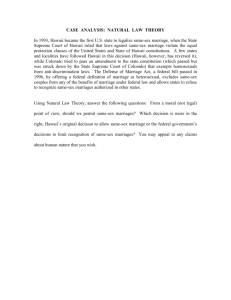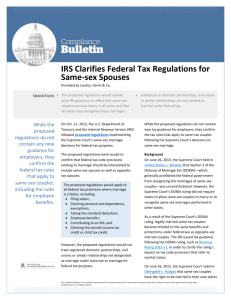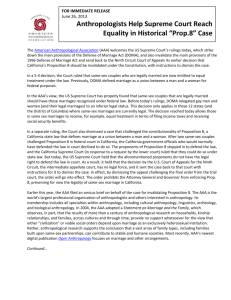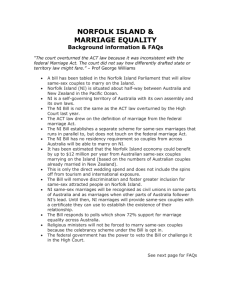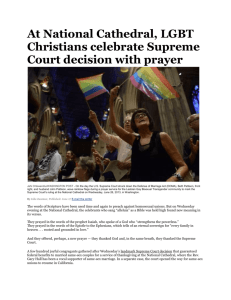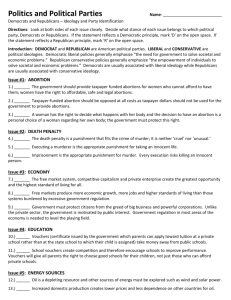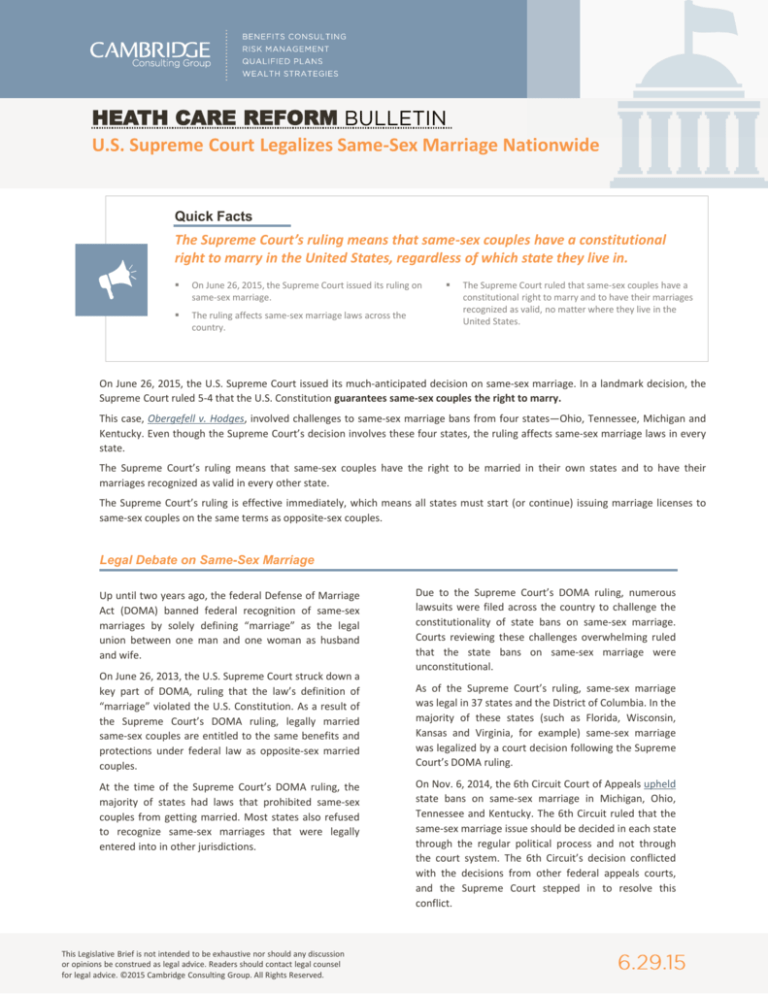
HEATH CARE REFORM
U.S. Supreme Court Legalizes Same-Sex Marriage Nationwide
Quick Facts
The Supreme Court’s ruling means that same-sex couples have a constitutional
right to marry in the United States, regardless of which state they live in.
On June 26, 2015, the Supreme Court issued its ruling on
same-sex marriage.
The ruling affects same-sex marriage laws across the
country.
The Supreme Court ruled that same-sex couples have a
constitutional right to marry and to have their marriages
recognized as valid, no matter where they live in the
United States.
On June 26, 2015, the U.S. Supreme Court issued its much-anticipated decision on same-sex marriage. In a landmark decision, the
Supreme Court ruled 5-4 that the U.S. Constitution guarantees same-sex couples the right to marry.
This case, Obergefell v. Hodges, involved challenges to same-sex marriage bans from four states—Ohio, Tennessee, Michigan and
Kentucky. Even though the Supreme Court’s decision involves these four states, the ruling affects same-sex marriage laws in every
state.
The Supreme Court’s ruling means that same-sex couples have the right to be married in their own states and to have their
marriages recognized as valid in every other state.
The Supreme Court’s ruling is effective immediately, which means all states must start (or continue) issuing marriage licenses to
same-sex couples on the same terms as opposite-sex couples.
Legal Debate on Same-Sex Marriage
Up until two years ago, the federal Defense of Marriage
Act (DOMA) banned federal recognition of same-sex
marriages by solely defining “marriage” as the legal
union between one man and one woman as husband
and wife.
On June 26, 2013, the U.S. Supreme Court struck down a
key part of DOMA, ruling that the law’s definition of
“marriage” violated the U.S. Constitution. As a result of
the Supreme Court’s DOMA ruling, legally married
same-sex couples are entitled to the same benefits and
protections under federal law as opposite-sex married
couples.
At the time of the Supreme Court’s DOMA ruling, the
majority of states had laws that prohibited same-sex
couples from getting married. Most states also refused
to recognize same-sex marriages that were legally
entered into in other jurisdictions.
This Legislative Brief is not intended to be exhaustive nor should any discussion
or opinions be construed as legal advice. Readers should contact legal counsel
for legal advice. ©2015 Cambridge Consulting Group. All Rights Reserved.
Due to the Supreme Court’s DOMA ruling, numerous
lawsuits were filed across the country to challenge the
constitutionality of state bans on same-sex marriage.
Courts reviewing these challenges overwhelming ruled
that the state bans on same-sex marriage were
unconstitutional.
As of the Supreme Court’s ruling, same-sex marriage
was legal in 37 states and the District of Columbia. In the
majority of these states (such as Florida, Wisconsin,
Kansas and Virginia, for example) same-sex marriage
was legalized by a court decision following the Supreme
Court’s DOMA ruling.
On Nov. 6, 2014, the 6th Circuit Court of Appeals upheld
state bans on same-sex marriage in Michigan, Ohio,
Tennessee and Kentucky. The 6th Circuit ruled that the
same-sex marriage issue should be decided in each state
through the regular political process and not through
the court system. The 6th Circuit’s decision conflicted
with the decisions from other federal appeals courts,
and the Supreme Court stepped in to resolve this
conflict.
HEALTH CARE REFORM
U.S. Supreme Court Legalizes Same-Sex
Marriage Nationwide
Supreme Court Decision
The Supreme Court was asked to rule on two specific issues—the power of the states to ban same-sex marriages and the power of
the states to refuse to recognize same-sex marriages performed in other states.
The Supreme Court held that marriage is a fundamental right under the Constitution for both opposite-sex and same-sex couples.
Thus, the Supreme Court ruled that every state must allow marriages between two people of the same sex and must also recognize a
marriage between two people of the same sex when their marriage was lawfully licensed and performed out-of-state.
The Supreme Court noted that the institution of marriage has evolved over time in response to developments in law and society. The
Supreme Court outlined four legal principles that supported its ruling that marriage is a fundamental right for both same-sex and
opposite-sex couples. These legal principles are as follows:
The right to personal choice regarding marriage is inherent in the concept of individual autonomy;
The right to marry supports a two-person union unlike any other in its importance to the committed individuals;
Marriage safeguards children and families; and
Marriage is a keystone to our social order.
Impact on Supreme Court Decision
The Supreme Court’s decision impacts the legality of same-sex marriages throughout the country.
By ruling that state laws prohibiting same-sex marriage are unconstitutional, the Supreme Court has effectively legalized same-sex
marriage in all 50 states. Same-sex couples will be allowed to marry in any state, and will be entitled to all the rights, benefits and
obligations given to opposite-sex spouses under both federal and state law.
Also, due to the Supreme Court’s ruling, employers will generally be required to treat employees in same-sex marriages the same as
employees in opposite-sex marriages for many federal and state law purposes.
Many federal laws have already been interpreted to include both same-sex and opposite-sex marriages due to the Supreme Court’s
decision on DOMA. The Supreme Court’s most recent ruling will expand these legal rights and protections to additional couples.
Also, many state law leave rights for legally married spouses should extend to employees with same-sex spouses. Same-sex married
couples should also be subject to the same state tax rules as opposite-sex married couples. State insurance laws may require
employers with insured health plans to offer equal health plan coverage to opposite-sex and same-sex couples.
The Supreme Court did not consider whether federal nondiscrimination laws should be expanded to protect workers from
discrimination based on sexual orientation or gender identity. However, a number of states have laws that prohibit such workplace
discrimination. Employers should keep any applicable laws in mind when providing any rights or benefits to employees.
More Information
Cambridge Consulting Group is dedicated and committed to providing you continuous updates on the Affordable Care Act (ACA). To
ensure that our clients stay ahead of the law, we will continue to utilize specific tools and to provide guidance and analysis to allow
you to make informed decisions regarding all upcoming regulations, how they will impact your organization and what benefit plan
strategies should be implemented moving into 2016 and beyond! Please contact your Account Director or Manager if you have
further questions.
This Legislative Brief is not intended to be exhaustive nor should any discussion
or opinions be construed as legal advice. Readers should contact legal counsel
for legal advice. ©2015 Cambridge Consulting Group. All Rights Reserved.
CAMBRIDGE-CG.COM
2


